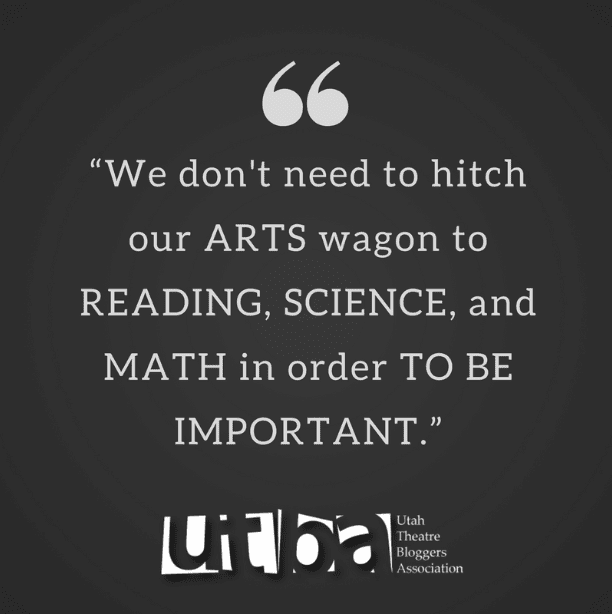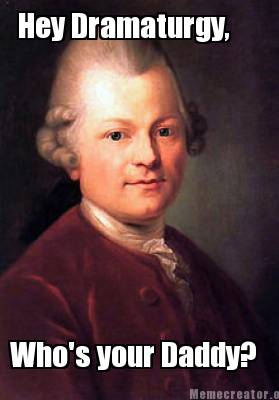In my day job as an educational psychologist, I read over 300 scholarly articles and books per year. A lot of these discuss how to raise academic achievement (i.e., grades, test scores) in children. But because of my moonlighting gig as a theatre critic, a new article grabbed my attention. Titled “Does Participation in Music and Performing Arts Influence Child Development?”, the article was written by E. Michael Foster (University of Alabama at Birmingham) and Jade V. Marcus Jenkins (University of California, Irvine). Much to the dismay of many UTBA readers, the answer to the article’s title question is “no.” But that’s OK. The arts don’t need to make any outside impact to still be a worthy part of the educational curriculum.

A young actor performing in the Adams Shakespearean Theatre at the 2012 Utah Shakespeare Festival Shakespeare Competition.
It is true that children who participate in the arts tend to do better in school and have better outcomes in adolescence and adulthood. But this is not proof that arts education causes these beneficial outcomes. That is because kids who take lessons in the arts differ from kids without arts lessons in many ways. For example, children receiving arts lessons generally are from more economically prosperous families.
Summary: Study Design
Foster and Jenkins used data from 1,944 children in the Panel Study of Income Dynamics Child Development Supplement dataset, which is part of a long-running study of American families based at the University of Michigan. To isolate the impact of arts education on these children, the authors controlled for 38 variables collected before the children started arts lessons. These variables included self-concept, health, IQ, reading and math scores, parental income, and more. Foster and Jenkins used a procedure called propensity score matching, which is a modern method for controlling for large numbers of confounding variables.
Summary: Results
The researchers found that, before controlling for the 38 variables, students with arts education experiences did better on many academic and life outcomes. But after controlling for the other variables, the benefits of arts education almost completely washed away. There were a few minor exceptions: children who had music lessons were more likely to participate in the arts as young adults. Also, children who had performing arts lessons (defined as dance and theatre) were more likely to participate in the arts, and had a 10 percentage point difference in high school graduation. Before this last result impresses you, it is important to note that 90% of the group that did not have performing arts lessons graduated from high school. Therefore, adding arts education to a high school is not going to turn a dropout factory into an excellent high school.
Discussion
To some readers, these results might be depressing. Schools sometimes seem relentless in their focus on the core subjects: language arts, math, and science. Arts advocates feel like this focus has come at the expense of the arts and extracurricular activities. Some people have argued that if arts education could raise student achievement in these core subjects, then funding arts education would be beneficial. Foster and Jenkins’s study dashes the support for this pro-arts education argument.
But as an advocate for the arts, I’m comfortable with this study’s results because the arts are important in their own right. Theatre, music, and the other arts enrich life and expose people to different viewpoints and new ideas. We don’t need to hitch our arts wagon to reading, science, and math in order to be important. Indeed, if we make the argument that the arts are important primarily because they improve children’s understanding of core academic subjects, we are relegating the arts to second class status. The arts shouldn’t be subservient to the rest of curriculum.
 Finally, I’m glad that Foster and Jenkins showed that participating in the arts as a child increased arts participation in early adulthood. This is great news for the arts community because it shows how to sustain and grow audiences: expose people to the arts while they’re young. We do a great job of that in Utah, as demonstrated by the many plays targeted at young audiences and the strong arts education programs in local schools. No wonder why Utah has the highest arts attendance rate in the country.
Finally, I’m glad that Foster and Jenkins showed that participating in the arts as a child increased arts participation in early adulthood. This is great news for the arts community because it shows how to sustain and grow audiences: expose people to the arts while they’re young. We do a great job of that in Utah, as demonstrated by the many plays targeted at young audiences and the strong arts education programs in local schools. No wonder why Utah has the highest arts attendance rate in the country.
There’s a lot more in Foster and Jenkins’s study, and I encourage people to read the full article, which I have cited below. Their work is methodologically very high quality, and the National Endowment of the Arts was savvy in sponsoring this study. My short summary of their work does not do justice to the entire article.
References
Foster, E. M., & Jenkins, J. V. M. (2017). Does participation in music and performing arts influence child development? American Educational Research Journal, 54, 399-443. doi:10.3102/0002831217701830





